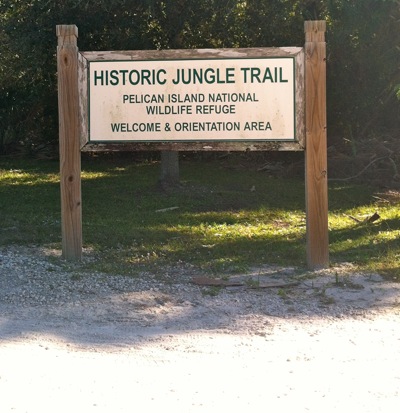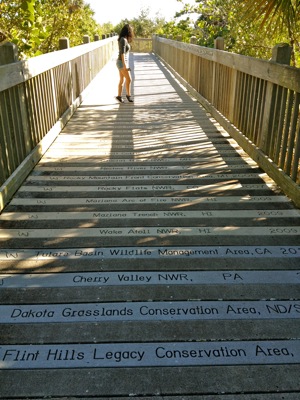
Pelican Island refuge is relaxing escape
SEBASTIAN, Fla. — It was a sunny, clear day as my two younger sisters and I drove north on A1A. Suddenly, my 13-year old sister Sarah alerted me that the turn for Pelican Island was coming up.
“Look! Look!” she yelled as she pointed to a brown sign that said “Pelican Island Viewing Area.”
I made a quick left turn onto a tree-shrouded dirt road.
“Well, that came out of nowhere,” I told her as I continued on the dirt road for a few minutes. If it wasn’t for Sarah’s vigilance I might have missed the turn altogether.
| Click on the video to the right to see an audio slideshow about visiting Pelican Island National Wildlife Refuge narrated and prepared by writer Vanessa Ramos. |
Although we are Sebastian natives, this was our first time at Pelican Island National Wildlife Refuge. I drove slowly so that we could take in the surroundings. There was a sign that said, “Historic Jungle Trail.” It connected A1A to the viewing area for Pelican Island.
There were palm trees and other shrubbery lining the road. My 17-year-old sister Natalie made me stop so that she could take a picture of a sign that warned of a $500 fine for taking land crabs.
“Wow, they’re really serious about their animals here,” she said.
I reminded her that this was the nation’s first wildlife refuge and that of course they would take animals seriously.
We crept along the dirt Jungle Trail for a little longer until a small parking area came into view. A tall crane appeared and blocked the road.
 |
At left, the Historic Jungle Trail leads visitors from A1A to Pelican Island National Wildlife Refuge (Photos by Vanessa Ramos). Below, the Indian River Lagoon meets the walking trails at Pelican Island National Wildlife Refuge in Sebastian, Fla. |
“And here we have the rarest of creatures,” Sarah joked in her best South African accent. “This feels like we’re on safari.”
“I doubt we’ll see any lions or zebras,” I said as the crane took its time crossing the road.
I had already done research and was expecting to encounter many different types of animals during our visit.
I had also contacted Heather Stapleton, an environmental director at the Environmental Learning Center, or ELC. This center provides educational programs about the Indian River Lagoon where Pelican Island is located.
“Primarily due to its unique location at the boundary between the temperate and subtropical zones, the Indian River Lagoon is the most biologically diverse estuarine system in the continental United States, supporting more than 4,700 species of animals and plants,” Stapleton told me.
I reminded my sisters to be on the lookout for animals as I pulled into a parking spot. In front of the line of empty spots was a wooded kiosk with signs and brochures.
We walked up to the informational station and briefly read about the history of Pelican Island and its national significance.
“Hey, let’s go through there,” Natalie said pointing to a small bridge that led into the woods just left of the kiosk.
“Let’s not. That looks really dark and creep. And besides, the viewing area is in the opposite direction,” I said as I inspected the map on one of the brochures.
My sisters and I agreed that it was odd that this smaller trail was not marked and did not look safe or welcoming.
We hopped back in the car and followed the signs for the viewing area. Another parking lot with empty spots came into view.
After parking we got out of the car and walked along the dirt path. The brochure map made it seem like there were several paths that were easily accessible from the main road, but the only one we saw signs for was the Centennial Trail.
This trail took us past other informational kiosks and meandered around the Indian River Lagoon. I expected to see animals lurking around the bank where the land and dark blue water met, but all we saw were birds in the distance, bees, and butterflies.
The cool 70-degree breeze felt nice as we continued our walk along the dirt trail that eventually turned into pavement and then a boardwalk.
“This leads to the observation tower where we can see Pelican Island,” I told my sisters as I shaded my eyes from the bright sun.
 |
At left, the Centennial Trail Boardwalk at Pelican Island National Wildlife Refuge. Below, the observation tower where visitors can look see Pelican Island |
Before visiting Pelican Island, I asked Heather Stapleton from the ELC why people weren’t allowed onto the actual island.
“Basically, access is restricted to help protect the island and let the birds nest undisturbed,” she explained. “Many of the birds are on the endangered species list and need the extra protection. There are also a few spoil islands in the Indian River Lagoon that are so important for bird nesting activity that they are recognized as conservation islands, too.”
The Centennial Trail seemed undisturbed as well. My sisters and I were the only people on it the day we visited, which made it feel like our own secluded walkway. There were no rangers or guides along the way to tell us about the island. Neither was there a main office or welcoming center.
The boardwalk was clean and felt secure. The names and locations of all the other national wildlife refuges were engraved on individual planks on the boardwalk along with the year they were established.
The boardwalk slightly inclined, providing us with a better view of the lagoon and mangroves below.
At the end of the boardwalk was the 18-foot observation tower that featured a map of the surrounding islands and two “spotting scopes” that we looked into to get a closer view of Pelican Island.
The trail and all the informative signs along the way culminated in an incredible view of the island. From the observation tower we could see pelicans diving into the water and catching fish in their mouths.
The round trip walk took us about on hour. And although the walk was pleasant, I wasn’t surprised that there weren’t other people there.
The ELC’s Stapleton had mentioned to me before my visit that people just aren’t visiting these types of nature sites compared to past years..
“Unfortunately, multiple studies have shown that today’s humans, adults and kids alike just aren’t spending much time in nature as compared to past generations.”
For me, Pelican Island National Wildlife Refuge was a relaxing escape from reality and a place I will definitely return to the next time I’m in Sebastian.
If You Go
Pelican Island National Wildlife Refuge
- Located in Sebastian, Fla., on A1A, south of Sebastian Inlet and north of Vero Beach.
- Directions From I-95: Take Exit 156 and continue on Fellsmere Road to U.S. 1 in Sebastian. Turn right onto U.S. 1 traveling south, turn left at the intersection of Wabasso Road, continue on over the Indian River Lagoon to the intersection of A1A, turn left on A1A traveling north and drive 3.7 miles and turn left onto Historic Jungle Trail.
- Hours: 7:30 a.m. – sunset. Open Mondays – Sundays.
- Parking fee and entrance fee: None
- Disabled accessibility: Yes
- Phone: 772-581-5557
- Website: http://www.fws.gov/pelicanisland/

Comments are Closed